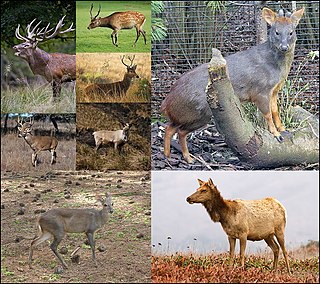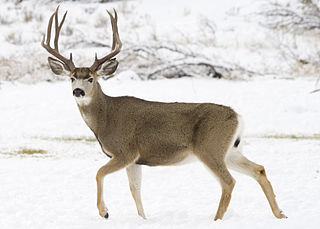
A deer or true deer is a hoofed ruminant mammal of the family Cervidae. The two main groups of deer are the Cervinae, including muntjac, elk (wapiti), red deer, and fallow deer; and the Capreolinae, including reindeer (caribou), white-tailed deer, roe deer, and moose. Male deer of all species, as well as female reindeer, grow and shed new antlers each year. In this, they differ from permanently horned antelope, which are part of a different family (Bovidae) within the same order of even-toed ungulates (Artiodactyla).

The Tongass National Forest in Southeast Alaska is the largest U.S. National Forest at 16.7 million acres. Most of its area is temperate rain forest and is remote enough to be home to many species of endangered and rare flora and fauna. The Tongass, which is managed by the United States Forest Service, encompasses islands of the Alexander Archipelago, fjords and glaciers, and peaks of the Coast Mountains. An international border with Canada runs along the crest of the Boundary Ranges of the Coast Mountains. The forest is administered from Forest Service offices in Ketchikan. There are local ranger district offices located in Craig, Hoonah, Juneau, Ketchikan, Petersburg, Sitka, Thorne Bay, Wrangell, and Yakutat.

The sika deer, also known as the Northernspotted deer or the Japanese deer, is a species of deer native to much of East Asia and introduced to other parts of the world. Previously found from northern Vietnam in the south to the Russian Far East in the north, it is an uncommon species that has been extirpated in most areas of its native range, except in Japan, where it is overabundant and present in very large numbers.

The white-tailed deer, also known commonly as the whitetail and the Virginia deer, is a medium-sized species of deer native to North America, Central America, and South America as far south as Peru and Bolivia, where it predominately inhabits high mountain terrains of the Andes. It has also been introduced to New Zealand, all the Greater Antilles in the Caribbean, and some countries in Europe, such as the Czech Republic, Finland, France, Germany, Romania and Serbia. In the Americas, it is the most widely distributed wild ungulate.

The mule deer is a deer indigenous to western North America; it is named for its ears, which are large like those of the mule. Two subspecies of mule deer are grouped into the black-tailed deer.

The Sitka deer or Sitka black-tailed deer is a subspecies of mule deer, similar to the Columbian black-tailed subspecies. Their name originates from Sitka, Alaska, and it is not to be confused with the similarly named sika deer. Weighing in on average between 48 and 90 kg, Sitka deer are characteristically smaller than other subspecies of mule deer. Reddish-brown in the summer, their coats darken to a gray-brown in mid- to late August. They are also good swimmers, and can occasionally be seen crossing deep channels between islands. Their average lifespan is about 10 years, but a few are known to have attained an age of 15.

Scent gland are exocrine glands found in most mammals. They produce semi-viscous secretions which contain pheromones and other semiochemical compounds. These odor-messengers indicate information such as status, territorial marking, mood, and sexual behaviour. The odor may be subliminal—not consciously detectable. Though it is not their primary function, the salivary glands may also function as scent glands in some animals.

The Columbian white-tailed deer is one of the several subspecies of white-tailed deer in North America. It is a member of the Cervidae (deer) family, which includes mule deer, elk, moose, caribou, and the black-tailed deer that live nearby.

The California mule deer is a subspecies of mule deer whose range covers much of the state of California.

Odocoileus lucasi, known commonly as the American mountain deer, is an extinct species of North American deer.
The Cedros Island mule deer is a subspecies of mule deer found only on Cedros Island off the coast of Baja California. Only about 50 individuals remain, with no captive population. Its behavior is similar to that of other subspecies of mule deer. The subspecies is threatened by feral dogs and poaching.

There are at least 14 large mammal and 50 small mammal species known to occur in Glacier National Park.

The Alexander Archipelago wolf, also known as the Islands wolf, is a subspecies of the gray wolf. The coastal wolves of southeast Alaska inhabit the area that includes the Alexander Archipelago, its islands, and a narrow strip of rugged coastline that is biologically isolated from the rest of North America by the Coast Mountains.

The Alberta Mountain forests are a temperate coniferous forests ecoregion of Western Canada, as defined by the World Wildlife Fund (WWF) categorization system.

There are at least 9 large terrestrial mammals, 50 small mammals, and 14 marine mammal species known to occur in Olympic National Park.
The Maybeso Experimental Forest is an experimental forest on Prince of Wales Island in Alaska. It is located near Hollis, Alaska within the Tongass National Forest and is administered by the United States Forest Service. The area of the forest is approximately 1,101 acres (446 ha), with a peak elevation of 2,953 feet (900 m). The forest was established in 1956 to examine the effects of large-scale clearcut timber harvesting on forest regeneration and anadromous salmonid spawning areas. The Maybeso Experimental Forest is the site of the first large-scale clearcut logging operation in Southeast Alaska, and nearly all commercial forest was removed from the area between 1953 and 1960. Presently, the forest is an even-aged, second-growth Sitka spruce and Western hemlock forest.















